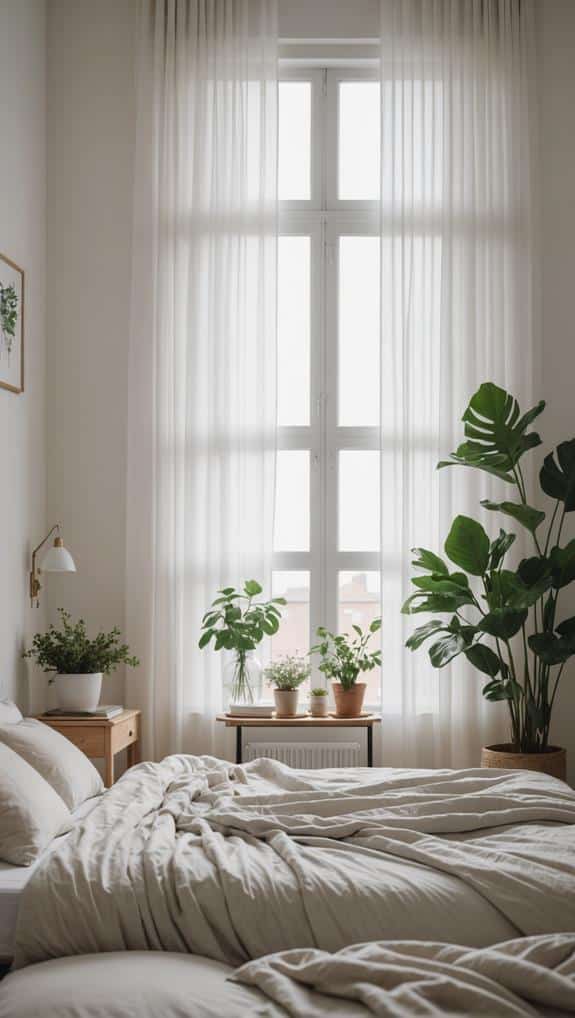At Chic Refuge, we understand the importance of creating a serene bedroom, and we’d like to share three essential Zen decluttering secrets from our extensive background in interior design and styling.
First, we advocate for adopting minimalist principles, emphasizing mindful consumption while keeping only items that truly bring joy or serve a purpose.
Next, we recommend organizing with intention, utilizing strategic storage solutions such as under-bed bins and wall-mounted shelves to maximize both space and functionality.
Finally, we suggest creating a calming aesthetic by selecting soft color palettes and incorporating natural textures, which work together to cultivate a soothing environment.
By implementing these thoughtful strategies, you’ll foster a tranquil sanctuary that is both functional and beautiful.
There’s so much more to explore in elevating your personal space.
Key Takeaways
- Adopt a minimalist mindset by assessing each item’s purpose and joyfulness, retaining only what truly enhances your space.
- Maximize open areas to promote calmness, reducing visual clutter with intentional organization of belongings.
- Implement strategic storage solutions, like under-bed bins and wall-mounted shelves, to maintain functionality while minimizing items on display.
- Choose calming colors and natural textures to craft a serene atmosphere that promotes relaxation and peace.
- Incorporate select plants to purify the air and bring a touch of nature indoors, enhancing the room’s overall serenity.
Embrace Minimalist Principles
To achieve a serene bedroom, we must embrace minimalist principles that encourage simplicity and tranquility. By focusing on mindful consumption, we can make intentional choices about what we bring into our space.
Let’s ask ourselves if each item truly serves a purpose, sparks joy, or contributes to our well-being. This approach helps us cultivate a bedroom environment that promotes rest.
Alongside mindful consumption, spatial awareness plays an essential role in creating that serene atmosphere. We should take a good look at our furniture and decor, considering how each piece affects the overall space.
By maximizing open areas and minimizing clutter, we can foster a sense of calm. Arranging our belongings with intention creates a flow that allows us to move freely, reducing stress.
As we shift to a minimalist mindset, we find that simplicity often leads to a more profound appreciation for each piece in our bedroom. This journey isn’t just about what we remove; it’s about celebrating what remains.
Together, we can transform our bedrooms into sanctuaries that reflect our values and foster tranquility, allowing us to recharge fully for each day ahead.
Organize With Purpose

A well-organized bedroom is more than just visually appealing; it’s essential for creating a tranquil space where we can truly unwind.
To achieve this, we need to focus on strategic storage and make intentional choices about what stays and what goes. First, let’s assess our belongings and identify what we truly need. Each item should serve a purpose or bring us joy; if it doesn’t, it’s time to contemplate parting ways.
Next, let’s implement strategic storage solutions that maximize space without sacrificing style. We could use under-bed bins for seasonal clothing or decorative baskets for items like blankets and books.
Every corner of our bedroom can be optimized—think wall-mounted shelves or hooks for accessories.
Create a Calming Aesthetic

Creating a calming aesthetic in our bedroom doesn’t have to be complicated; simple choices can make a big impact. By selecting calm colors like soft blues, gentle greens, or warm neutrals, we can set a tranquil tone. These shades not only create a sense of peace but also facilitate relaxation, making our sanctuary feel inviting and serene.
Next, we should consider incorporating natural textures. Materials like linen, wood, and stone can ground our space and add an organic feel. A linen duvet cover draping over a wooden bed frame can bring warmth and comfort, while a jute rug underfoot adds an earthy touch.
It’s the mix of these elements that stimulates the senses without overwhelming them.
We can also play with the concept of minimalism in decor, keeping surfaces free of clutter. A few carefully chosen plants can enhance the aesthetic and purify the air, contributing to our overall well-being.
Frequently Asked Questions
How Can I Maintain My Decluttered Bedroom Long-Term?
Ever wonder how we keep our space clutter-free? We focus on sustainable organization and develop daily habits, like tidying just a little each day. It’s surprising how small actions lead to lasting serenity!
What Should I Do With Sentimental Items?
When we’re faced with sentimental items, we should prioritize memory preservation. Let’s create a designated sentimental storage area, keeping only what truly matters, allowing us to cherish memories without overwhelming our space.
How Often Should I Declutter My Bedroom?
We believe establishing a decluttering schedule is essential. Regularly evaluating our bedroom essentials every three months keeps clutter at bay, ensuring our space remains peaceful and functional, allowing us to recharge effectively.
Can I Declutter if I’m Not a Minimalist?
Think of our spaces like gardens; they need care. We can declutter, even if we’re not minimalists. By honoring our style and acknowledging emotional connections, we’ll create harmony without sacrificing the things we cherish.
How Do I Handle Clutter in Shared Bedrooms?
We handle clutter in shared bedrooms by establishing clear communication strategies. Let’s discuss our space, set mutual expectations, and create organized zones, ensuring everyone feels comfortable and responsible for maintaining our shared spaces.





